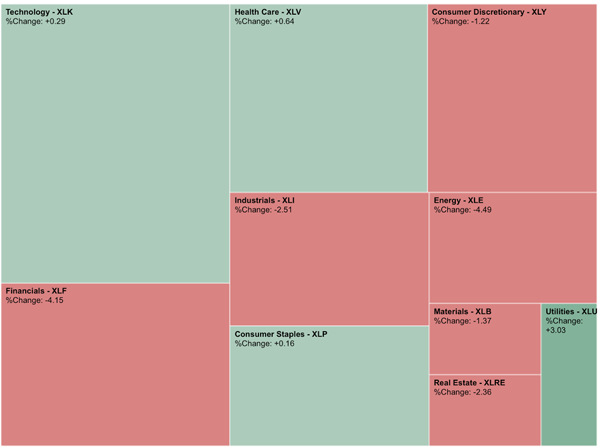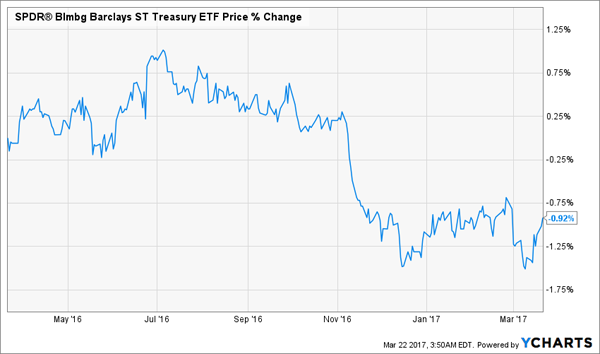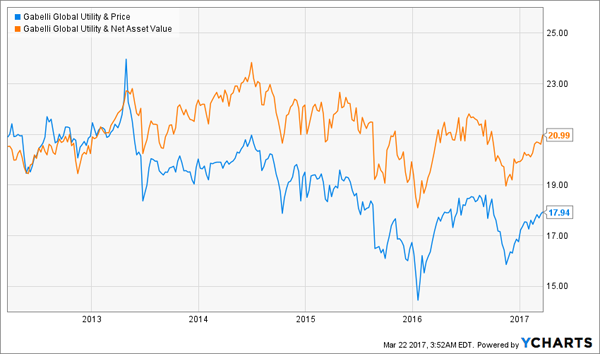We might be at the start of a correction.
[ad#Google Adsense 336×280-IA]This doesn’t mean it’s time to sell, but it does mean it’s time to be really, really choosy.
Just look at financial stocks.
I’ve been closely following this sector and timing buys and sells for myself based on the market’s irrational overreactions to news.
That means I recommended buying financials in August 2016, then recommended avoiding the sector [earlier this month].
Here’s what’s happened since then:
Financials Drop, Utilities Jump

So financials have underperformed everything else. But it’s still too early to jump into the sector, since it’s still up 21% over the past year.
I’m not the only one who feels this way about financial stocks. Hedge fund manager Doug Kass just wrote a long article titled “A Long Course on Why You Should Be Short Financials.”
There’s a lot in it, but the point I find most interesting is Kass’s argument that rising interest rates aren’t good for banks because they will lower demand for mortgages, which retail banks rely on. This is an interesting view, especially because it’s contrary to the market “wisdom” at the moment.
So let me extend Kass’s idea to the best-performing asset class in the past month: utilities.
Utilities aren’t directly influenced by interest rates, and the indirect connections to their underlying business are too tangential to really worry about. However, changes in interest rates do influence investor demand for utility stocks.
Lower rates tend to result in growing demand for utilities, since yields are hard to get elsewhere. In 2016, expectations of higher interest rates led investors to dump utilities, thinking rising rates would benefit other sectors, like financials.
Over the last six months, utilities are only up 2%, even after their 3% jump in the last month. If the market decides our rising-interest-rate environment isn’t enough to drive cash into financials, as Kass suggests will be the case, that may drive more demand for utility stocks, extending the past month’s 3% gain.
So which names should we buy? A few weeks ago, I pointed to five: WEC Energy Group (WEC), Great Plains Energy (GXP), SCANA (SCG), Dominion Resources (D) and Northwestern (NWE).
On average, these stocks are up about 3% in the past month, about the same as the Utilities Select Sector SPDR ETF (XLU), although my picks all have higher yields than XLU’s 3.2%.
I still think these stocks will outperform XLU over the long term and end up with a higher dividend yield, but whether you choose my picks or the index fund, you’re going to have to wait a few years to get a payout over 6%.
Granted, my picks will probably get there a couple years faster, but what if you want sustainable 6% income right now, plus strong short-term capital gains potential as you anticipate a rush into utilities?
If you want high income and a quick buck, here are a couple funds that might work for you.
The first is the Macquarie Global Infrastructure Total Return Fund (MGU), which is currently trading at a 13.9% discount to its net asset value (NAV) and yielding 6.8%.
The fund is heavily invested in the US, which accounts for 40% of its assets, although its top three holdings are more international. There’s the Australian Transurban Group (TCL) alongside Sempra Energy (SRE) in America and Enbridge (ENB) in Canada. The fund has also handily beaten XLU over the last year while offering a yield that doubles that of the index fund:
Outperforming the Index

Then there’s the Gabelli Global Utility & Income Trust (GLU), which is paying a 6.7% dividend and trading at a 14.5% discount to NAV. Even though the fund has a similar mandate as MGU, there’s surprisingly little overlap. Gabelli is investing 63% of its assets in North America and 30% in Europe, but surprisingly, the fund had short-term Treasuries as three of its top holdings at the end of 2016.
Why? There are many possible reasons, but the likeliest is that the fund’s manager, famed value investor Mario Gabelli, believed investors’ expectation that rising interest rates in 2017 would obliterate Treasuries was overstated. A quick glance at the performance of the SPDR Short-Term Treasury ETF (SST) performance over the past year suggests he was right:
Priced-in Pain

As a result, GLU’s NAV has soared since the start of 2017:
GLU’s Value Soars

That’s smart money management that commands respect. But the market hasn’t given this fund the accolades it deserves since 2013—the last time it traded at a premium to NAV:

Now is the time to reward GLU for its wise responses to market conditions before other investors do. Likewise, it’s time to add MGU to a utilities portfolio and get global diversification. Together, these two funds will hand you 6.7%+ yields and strong capital gains potential in the short term.
— Michael Foster
Sponsored Link: Here’s something else I think you’ll love: you can juice these funds’ yields even more by adding 3 other closed-end funds topping our buy list now.
They pay even more than GLU and MGU—and I don’t mean a little more.
The lowest yielder of the bunch hands you a safe 8.2% today, and the highest takes you into double digits! At 10.1%, you’ll kick-start a safe $20,000 income stream if you drop $200,000 into this one now.
And, with ridiculous discounts of 10% to 15% to NAV—sure to snap shut when the herd gets over its interest rate fears—you can look forward to quick gains in short order, too!
I’ve put everything you need to know about these 3 snubbed funds and 3 other “hidden” high-yield investments in 3 new reports you can get FREE right now.
Together, these 6 bargain buys from our “8.0% No-Withdrawal Retirement portfolio”—our one-stop solution for the safe, steady income you need to backstop your Golden Years … and double-digit yearly gains that will grow your nest egg fast.
You do not want to be left behind here. Don’t wait. Click here to get the full story in these 3 FREE special reports now.
Source: Contrarian Outlook
